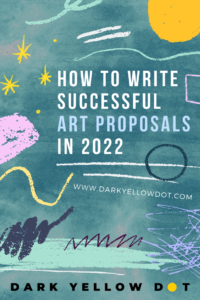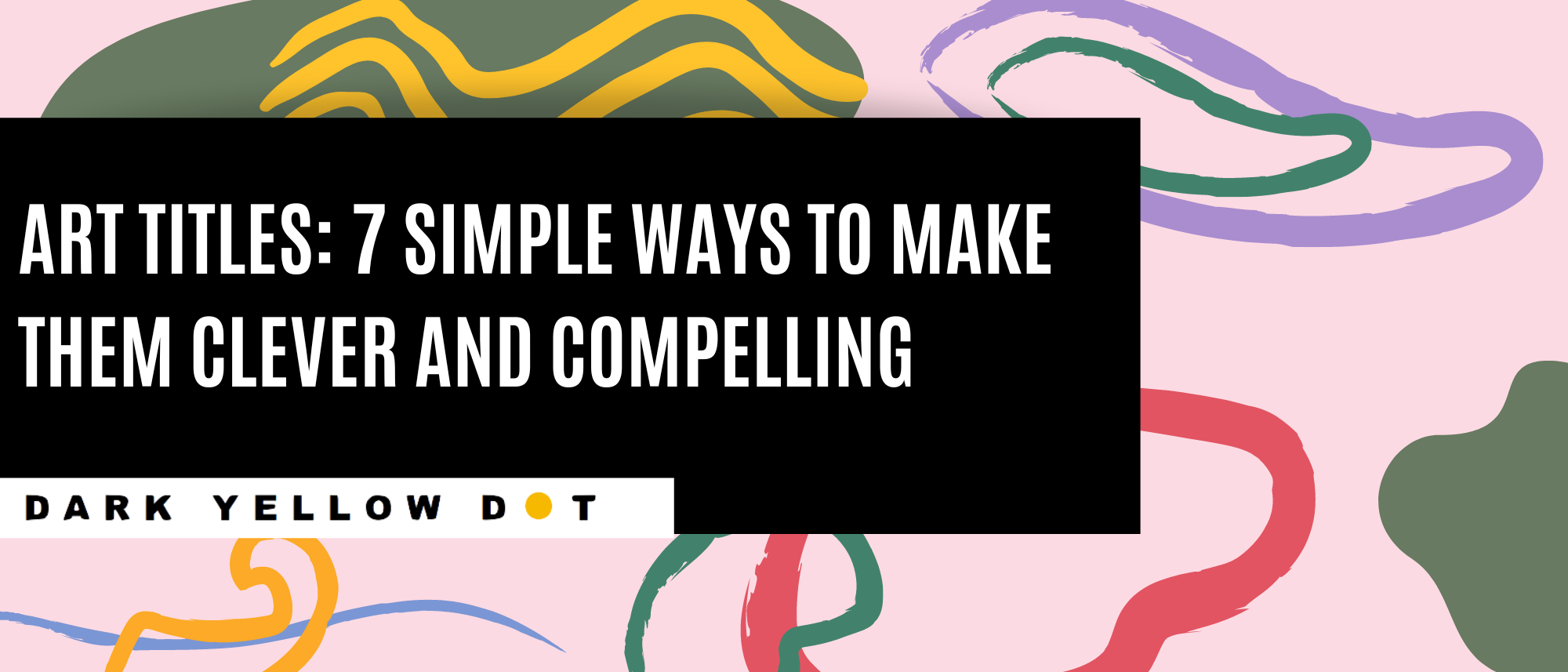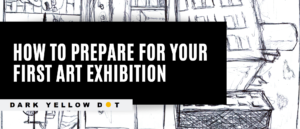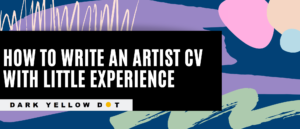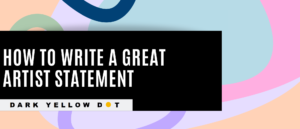
How To Write A Successful Art Proposal (Easy Tips For Artists)
Heads up: This post may contain affiliate links. Learn more.
Tips For Writing An Art Exhibition Proposal For The First Time
As artists, we’re usually pretty confident with making something visual. In most cases, it’s the very process that drives our work. But there are a lot of other skills outside of our visual practice that creative individuals need in order to be successful, and writing an art proposal is one of them.
In general, writing will always be an important tool to possess when you’re within the creative industries; whether you’re drafting an artist statement, updating an artist CV or simply explaining your art to people. So, knowing how to write an art proposal comes under a long list of jobs that an artist will have to do, especially if they’re preparing for an exhibition of some sorts.
What is an art proposal?
An art proposal is a document that lays out an individual’s creative ideas for some kind of event, project or piece of work. It can come under various names such as a gallery proposal, exhibition proposal or project proposal. Usually, such proposals result in exhibitions, but they’re also used to fill artist residencies, grants and other art projects.
What matters here is your ability to clearly communicate your ideas, intentions and realisations through a written format. The text needs to persuade a reader through its excitement and potential, whilst also being realistic. Of course, images of your best and relevant work are needed too, but convincing your reader through your words will ultimately lead to a successful application or not.
You may find that the advice in this article is applicable to other types of proposals, and to an extent this is true. However, art proposals are very different from residence applications or grants. For example; artist grants require a more detailed explanation as the establishment you’re applying to needs to know that you are a worthy recipient and that the project will be mutually beneficial. For help with these types of proposals, The White Pube has a growing funding library resource of successful examples that anyone can view. We took a deep dive into the topic of funding applications over in our art club, with an informative art talk available to watch and replay.
How to write an art proposal for an exhibition?
Preparing to write an art proposal
Hopefully you’ve started this whole process in good time with the deadline still being some weeks away. Preparation is key in this scenario, as jumping in with all of your spiralling ideas can throw you in different directions.
Do your research
Starting early gives you time to do some critical research behind the gallery or institution you’re approaching. How can you explain why a gallery should work with you if you know nothing about them?
Take a look at their previous exhibitions and artists they’ve worked with in the past to see if you can draw comparisons. The space you’re looking to exhibit in may be suited for one kind of practice more than another, so before wasting your time sending a proposal, artists should make sure their work fits the site that they’re looking into. By contextualising your proposal in relation to the gallery’s history and agenda, you’re showing that you’re invested in their collective vision as well as your own. It may even help to reach out to the artists that had previously worked with the institution.
Read the instructions carefully
This sounds obvious, but you can never read their instructions too many times. This is particularly important if the gallery or organisation has a dedicated application process that you need to fill in. Don’t ruin your chances by simply attaching a document in the wrong format or sending one too many images. Your art proposal may be great, but if you haven’t matched their requirements, your work will be disregarded.
What to write in an art proposal?
It’s difficult to know how to write an art proposal straight off the bat, even with the knowledge you would have acquired through some prior research. If the application process doesn’t already outline direct questions or you’re just pitching a potential idea; start by asking yourself these basics so you don’t miss important things:
- What will I make / what have I made? Describe its visual properties, including scale and materials. Consider health and safety implications and how you would install. You could include an art title here if you have one.
- What are the influences behind the work? Include your most pertinent inspirations and what the art is trying to communicate.
- What does this work do for your practice at the moment in time? Why is it important to your career as an artist?
- How does this proposed idea benefit the gallery/project/organisation? How does it link to their vision?
- How does the work respond to the site that you wish to display it? Consider the surrounding community that will see the work.
By following these points, you should have already formed a solid base of text that covers everything that the reader could want to know. Now it is about perfecting this draft so that it reflects your practice in the best possible light.
What format should an art proposal be?
There’s no one size fits all when it comes to artist proposals, as they will all require individual and particular elements depending on what gallery or institution you’re applying to. Some will be multiple page documents with various attachments, whereas others will simply be a 1 page project proposal. It can be difficult to know what an exhibition proposal should look like, therefore it’s very important to read the specific requirements or ask if you’re unsure.
Some proposal formats are very structured, with the gallery already having an existing application form for you to fill in, similar to Dark Yellow Dot’s open call applications. These types of proposals prompt you to include certain things with their specific questions, so as it may feel easier to complete, be sure to answer the question directly and give the reader what they’ve asked for. Also look out for the character limits on these, as they’ll often indicate how many words you can use. Make sure you get all your main points explained clearly within the restrictions.
Other organisations may ask you to send proposals via email, in which case the format is down to you. These types of art proposals can range from heavily structured to more elusive written text, a bit like Phyllida Barlow’s exhibition proposal example for the Tate. It’s up to the artist to decide how to write an art proposal, but here are some main tips for keeping it in line with the industry standard.
Start by introducing yourself in an artist bio or artist statement.
This doesn’t mean you need to include your life story; just a bit about where you’re currently practising in and where.
Make sure the first few sentences of the proposal part are strong, summarising your ideas in a captivating way.
You want the reader to have a clear, initial sense of what your work is about and create enough excitement around your art that they continue reading.
Use simple language, writing clearly and concisely.
Try to avoid throwing in art jargon and over-complicated terms to impress the reader. The most important thing is that they understand what you’re trying to convey.
When addressing the actual exhibition plans, be specific.
It doesn’t help to be vague as the gallery needs to know whether your plans are viable for their space. Talk about the individual works you will show in detail, with a brief overlook on how this relates to your practice as a whole. It may be useful to consider the practical installation process here.
With images, it is always best to go with quality over quantity.
Using high quality photos shows you’re a professional artist that takes their practice seriously. If you’re not regarding your own work highly, then you can’t expect someone else to. Remember to use accessible file formats, especially if there are specific ones indicated in the requirements, like JPG, PNG and more.
To go with the images, you will usually require an image list too.
These can be relatively simple with a clear annotation describing what is in the photo. Make sure each label matches with the right photo through numbering them. See below for an example.
Image 1:
[Artist’s name]
[Birth year]
[Title of the artwork], [Year created]
[Medium used to create]
[Optional brief description, sometimes including the place in which it’s being shown]
– The art exhibition proposal should look smart, professional and clean. Avoid making it stylized and fancy (unless you’re asked to) otherwise you’ll end up distracting the reader from the important content. Leave the visual elements to your high quality photos and ensure the text is readable. Where the formatting isn’t indicated, it’s best to opt with a text size of 11 or 12 in the New Times Roman font style and a line spacing of 1.5.
– Don’t forget to include your contact details and links to your artist website, portfolios or social media accounts that show more of your creativity and talent.
Final tips
Are you struggling to turn your art proposals into successful applications? Try putting some of these tips into practice and see if it makes a difference!
Keep all your copies of art proposals in neatly organised folders
By tracking your applications; you’ll be able to identify which areas you need to improve and build a collection of varying proposals which will help you write similar new ones when needed.
Don’t be afraid to ask the gallery or organisation some questions
If it’s a fairly large establishment, they may not take direct queries regarding individual proposals and instead offer general advice; but it doesn’t hurt to try. It’s also beneficial for them to make sure the proposals they receive are in line with their requirements, limiting the amount of time they’ll waste on rejected ones.
Start the proposal process early.
It’s simply not as easy as sitting down one evening and writing. An art proposal takes a fair amount of preparation as we’ve discussed above. Consider the time it will take to organise high quality photos of your work, to research the gallery, to allow for their replies to your questions and for you to formulate your ideas.
Be patient
Galleries receive hundreds of proposals even when they don’t advertise their open calls, so don’t expect an immediate response. Use your time to apply to other opportunities whilst you wait. After all, the more proposals you send off, the more likely you are to be successful.
Ask for feedback.
If you’re lucky, the gallery or institution may be able to send you some constructive feedback on why your proposal was rejected. Make note of what they say on another document or simply re-do the original to use as a template for future applications. This is the perfect way to improve your art proposals off the back of an unsuccessful attempt.
The whole process of writing an art proposal can be demanding, and with a few rejected applications it can be easy to give up. However, that moment when you get it right and see your vision come to life makes all the hard work worth it. So, our best advice is to keep at it and believe in your art because sooner or later, someone else will too.
HOW HAVE YOU HAD SUCCESS WITH WRITING ART PROPOSALS? LET US KNOW IN THE COMMENTS BELOW.
Don’t forget you can always share your art with us! Become the next Artist of The Month or tag us on Instagram @darkyellowdot.
Thank you for reading and if you found this article useful, share it around, that makes us happy. To receive updates and more posts like this just join our mailing list, everyone is welcome.
NEED MORE ADVICE?
ARTICLES TO HELP:
12 Tips On Preparing For An Art Exhibition For The First Time
How To Write An Artist CV When You Don’t Have Much Experience
How To Write An Artist Statement That People Will Want To Read
SITES TO HELP:
Funding Library I The White Pube
COURSES TO HELP:
The Art Of The Proposal: How To Create Web Proposals That Win Projects
Write Your Artist Statement In 3 Simple Steps
Write Winning Proposals For Freelance Jobs: The Ultimate Guide
